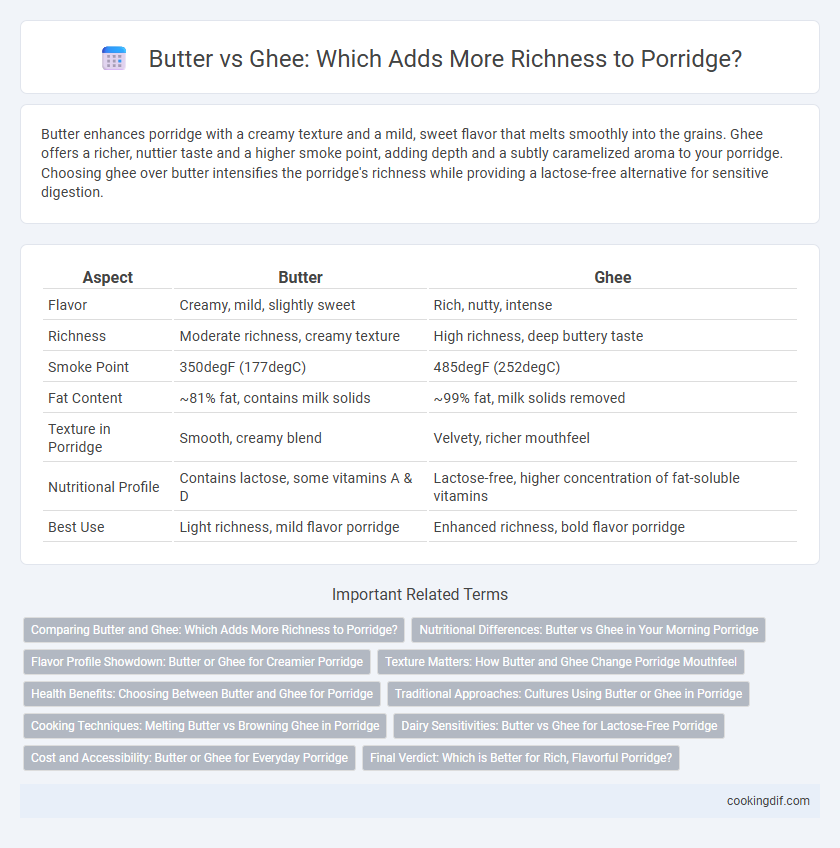Butter enhances porridge with a creamy texture and a mild, sweet flavor that melts smoothly into the grains. Ghee offers a richer, nuttier taste and a higher smoke point, adding depth and a subtly caramelized aroma to your porridge. Choosing ghee over butter intensifies the porridge's richness while providing a lactose-free alternative for sensitive digestion.
Table of Comparison
| Aspect | Butter | Ghee |
|---|---|---|
| Flavor | Creamy, mild, slightly sweet | Rich, nutty, intense |
| Richness | Moderate richness, creamy texture | High richness, deep buttery taste |
| Smoke Point | 350degF (177degC) | 485degF (252degC) |
| Fat Content | ~81% fat, contains milk solids | ~99% fat, milk solids removed |
| Texture in Porridge | Smooth, creamy blend | Velvety, richer mouthfeel |
| Nutritional Profile | Contains lactose, some vitamins A & D | Lactose-free, higher concentration of fat-soluble vitamins |
| Best Use | Light richness, mild flavor porridge | Enhanced richness, bold flavor porridge |
Comparing Butter and Ghee: Which Adds More Richness to Porridge?
Butter imparts a creamy, dairy-rich flavor to porridge due to its higher moisture content and milk solids, enhancing its smooth texture. Ghee, clarified butter with the milk solids removed, offers a more intense, nutty aroma and a higher fat concentration, providing deeper richness and a silkier mouthfeel. For porridge, ghee's concentrated fats contribute to a richer taste profile, while butter offers a gentler, creamier indulgence.
Nutritional Differences: Butter vs Ghee in Your Morning Porridge
Butter contains milk solids and water, providing small amounts of vitamins A, D, and E along with calcium, while ghee is clarified butter with most milk solids removed, resulting in higher concentrations of fat-soluble vitamins and a longer shelf life. Ghee offers a richer, nuttier flavor and contains more butyric acid, which supports gut health, whereas butter includes lactose and casein, potentially causing issues for sensitive individuals. Both enhance porridge richness, but ghee's higher smoke point and concentrated nutrients make it a preferred choice for savory porridge recipes focused on digestion and nutrient absorption.
Flavor Profile Showdown: Butter or Ghee for Creamier Porridge
Butter provides a rich, creamy texture with a mild, sweet flavor that enhances porridge's natural grain taste, while ghee offers a deeper, nutty aroma and robust buttery notes that intensify the porridge's richness. The clarified nature of ghee allows for a higher smoke point, making it ideal for cooking porridge without burning, which preserves its complex flavor. Choosing ghee or butter depends on whether a subtly sweet or intensely savory profile is desired for a luxurious porridge experience.
Texture Matters: How Butter and Ghee Change Porridge Mouthfeel
Butter adds a creamy, smooth texture to porridge, enriching its mouthfeel with a luscious, velvety consistency. Ghee imparts a slightly grainier, more intense richness due to its clarified nature, enhancing porridge with a nutty, buttery depth that lingers. Choosing between butter and ghee significantly impacts porridge's tactile experience, balancing softness versus richness in every spoonful.
Health Benefits: Choosing Between Butter and Ghee for Porridge
Ghee contains higher levels of beneficial fats like butyric acid and conjugated linoleic acid, which support digestion and reduce inflammation, making it a healthier choice compared to butter for porridge. Butter retains some milk solids and lactose, which can cause sensitivities in some individuals, whereas clarified ghee is lactose-free and more suitable for those with dairy intolerance. Both provide rich, creamy texture to porridge, but ghee's higher smoke point and antioxidant content offer additional health advantages.
Traditional Approaches: Cultures Using Butter or Ghee in Porridge
Traditional cultures in South Asia and the Middle East often use ghee to enrich porridge, leveraging its nutty flavor and high smoke point to enhance texture and taste. In contrast, many European and North American cultures prefer butter for porridge, valuing its creamy consistency and rich dairy notes that complement grains like oats. Both fats serve as integral components in regional porridge recipes, highlighting diverse culinary customs shaped by local ingredients and dietary practices.
Cooking Techniques: Melting Butter vs Browning Ghee in Porridge
Melting butter into porridge creates a creamy texture and mild, rich flavor, enhancing the porridge's smoothness. Browning ghee before adding it to porridge develops nutty, caramelized notes that deepen the overall taste complexity. The cooking technique directly influences the porridge richness by balancing smoothness with an aromatic intensity unique to browned ghee.
Dairy Sensitivities: Butter vs Ghee for Lactose-Free Porridge
Ghee offers a lactose-free alternative to butter, making it ideal for individuals with dairy sensitivities or lactose intolerance when enriching porridge. Unlike butter, ghee is clarified, removing milk solids that contain lactose and casein, which can trigger digestive discomfort. Using ghee in porridge enhances richness and creamy texture without the risk of lactose-related symptoms.
Cost and Accessibility: Butter or Ghee for Everyday Porridge
Butter generally offers more accessibility and lower cost compared to ghee, making it a practical choice for everyday porridge. Ghee, due to its longer shelf life and concentrated fat content, can be cost-effective in the long run despite higher upfront prices. Many households prefer butter for daily use because it is widely available in most grocery stores and requires no special storage conditions.
Final Verdict: Which is Better for Rich, Flavorful Porridge?
Ghee offers a richer, nuttier flavor and higher smoke point, making it ideal for enhancing porridge with a deep, aromatic taste. Butter provides a creamy texture and mild sweetness, but can burn more easily, potentially compromising the porridge's flavor. For a truly rich and flavorful porridge, ghee is the superior choice due to its concentrated fats and robust taste profile.
Butter vs Ghee for porridge richness Infographic

 cookingdif.com
cookingdif.com